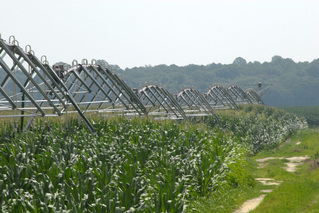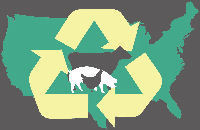 The MPCA feedlot program has issued a two-page guide for manure management for corn planted on irrigated sandy soils. This is based on nitrogen recommendations in the most recent University of Minnesota Extension Service publication.
The MPCA has allowed up to a total of 180 pounds of plant available nitrogen per acre for corn production when manure has been applied. However, irrigated sandy soils require specific management to control nutrient loss. Using best management practices (BMPs) is a recommended strategy to help reduce possible environmental impact. Extension recommends using the following BMPs:
- Use the Extension MRTN, (Maximum Return to Nitrogen) nitrogen recommendation.
- Fertilizer nitrogen applications must use a split program.
- No pre-plant fertilizer nitrogen (this includes no fall nitrogen application).
- Account for all sources of nitrogen and phosphorus fertilizers.
- Take credit for previous crop and manure application. (Eg. soybean is a 30 lb. nitrogen/acre credit.)
The guide is located on the feedlot program manure and nutrient management webpage.
Back to top
|
 Hydrologists
from the Minnesota Department of Natural Resources are reaching out to livestock
operators, county feedlot officers, and various farm organizations about requirements for water use permitting. A DNR water use (appropriation) permit is
required for all users of more than 10,000 gallons of water per day or 1
million gallons per year.
Although water
use for an individual feedlot may not seem significant, the water used for
washing, watering and sanitizing can be considerable even for small operations. The DNR
estimates that only 20 percent of feedlots may have the needed permits. This is
partly due to a transitional process as the DNR switches to a new electronic
permit system. This system, called MPARS (Minnesota DNR Permit and Reporting System) is accessible 24 hours a day and
provides an easy way to access information regarding water use.
The DNR monitors the “balance” or water levels
in the aquifer through a series of observation wells. However,
water use reporting provides much needed detail on the demands placed on aquifers
and how use may affect aquifer levels. Reporting provides insight on how each individual aquifer reacts to
different levels of use. Together
monitoring observation wells and water use reporting will help ensure a viable
continuous water supply for everyone. This is critical since these same aquifers provide water to supply
community needs, rural homes, irrigation, manufacturing, food processing and other uses.
Anyone who suspects
they might need a permit can visit MPARS (www.dnr.state.mn.us/mpars/index.html) and calculate
water use or apply for a permit. For
questions on water use, permitting or how to calculate water use, please
contact DNR Hydrologists Brent Beste at 507-389-8808 or Anne Nelson at
320-234-2550.
Back to top
|
Livestock producers with operating permits are required to submit annual reports by March 1. Those who have not yet sent in reports are urged to so do immediately. Failure to submit the report in a reasonable time may result in an enforcement action from the MPCA. Report forms
are available on the MPCA feedlot program website. Links to the form are
located on the feedlot program permits and forms webpage. Paper
copies of the form may be requested by contacting the MPCA regional offices. The office phone
numbers are listed on page 5. All land application records for the
12-month period starting Sept. 1, 2014, through Aug. 31, 2015, must be
submitted as part of the report and on the included forms. For farms that do
not transfer manure, land application records can also be generated and
submitted using the MPCA excel based Manure Management Planner under Create
Crop Year Records. A link to the planner is located on the feedlot
program Nutrient and Manure Management webpage.
Annual reports provide valuable information for determining compliance with
Minnesota’s feedlot rules.
Back
to top
MPCA feedlot staff are working to keep up with the large number of NPDES or SDS permit applications or renewals. The new State Disposal System permit and the 2016-2021 National Pollutant Discharge Elimination System permit combine to create a large workload in a short period of time. An estimated 1,000 NPDES general permits are being renewed, or in some cases, being replaced with the SDS permit. Livestock producers who have submitted applications but not yet received their operating permits will continue to be covered under their expired permit until the new one is received. Submitting complete and accurate application forms helps to keep the process moving well.
A single permit application has been developed for use when
applying for either the NPDES or the SDS permit. The manure management plan,
submitted as part of the permit application for either the SDS or NPDES permit,
must be done on a form provided by the MPCA. A fact sheet, titled “NPDES and SDS Permits
for Feedlots,” is available to assist in determining the type of permit
coverage preferred or required for a facility. Forms and factsheet can be found
on MPCA feedlot website at: https://www.pca.state.mn.us/quick-links/feedlot-program.
Back
to top
 Early morning sunlight reflecting on plumes from turkey barn vents - Submitted photo
County feedlot staff news
Training for new county feedlot program staff has been scheduled for April 26-27, followed by all staff training April 28 at the Days Inn in Hutchinson.
Jonah Olson is leaving the East Polk County feedlot program and will be joining the West Otter Tail SWCD staff.
Turkey growers cautious going into spring
Minnesota’s turkey
industry is back at full production. Minnesota Turkey Growers Association
executive director Steve Olson says turkey growers
are optimistic and cautious heading into spring. "We’re looking forward
like this is going to be a typical year, but we’re prepared as if we’re going
to have to deal with high path avian influenza like we did last year.” Olson
says turkey growers are prepared. “We held a meeting with state agencies last
week where everyone got together to talk about the plan if we got hit and the
purpose was to identify any gaps and to try to fill those gaps in the next week
or so. It was great to have everyone in the same room. It was less looking back
and more looking forward at how we’re going to deal with this if we need to
again.” Reported in Red River Farm Network News.
Windom processing plant sale finalized
Minnesota Timberwolves owner
Glen Taylor and his partners have closed on the PM Beef plant in Windom,
Minnesota. The new owners will convert the former beef plant to a
state-of-the-art pork operation. When fully operational, the plant is expected
to process between 4,000 and 5,000 hogs per day and employ around 350 people. Reported in Red River Farm Network News.
Lentsch to lead Midwest Dairy Association
South Dakota Agriculture Secretary
Lucas Lentsch will soon relocate to the Twin Cities and take over as the chief
executive officer of the Midwest Dairy Association. Lentsch announced this past
week that he was leaving the South Dakota Department of Agriculture for a job
in the private sector. At MDA, Lentch will succeed Mike Kruger. Kruger has been
in that role since 1985 and plans to retire on July 1. Lentsch was raised on
dairy farm in northeast South Dakota and has a degree in dairy manufacturing at
South Dakota State University. Reported in Red River Farm Network News.
New MPCA advisory committee appointed
Minnesota Governor Mark
Dayton has appointed eight people to his new Minnesota Pollution Control Agency
advisory committee. Two of the eight members have a connection to agriculture,
Nathaniel Hultgren and Ted Winter. Hultgren is the agronomy director for Meadow
Star Dairy at Willmar. Hultgren also farms with his brother at Raymond, raising
corn, soybeans, wheat, kidney beans, sugarbeets and alfalfa. Winter is an
insurance agent with Farmers Union Insurance and farms near Fulda in southwest
Minnesota. Winter spent 16 years in the state legislature, including two years
as the House majority leader. The MPCA Citizen’s Board was eliminated during
the 2015 legislative session. The advisory committee does not have the
authority seen with the Citizen’s Board, but will provide input the MPCA
commissioner. Reported in Red River Farm Network News.
Back to top
 Veterinary Feed Directive, Antibiotic Resistance, and Animal
Agriculture - This webcast will examine the veterinary feed directive and how it impacts
animal agriculture as well as discuss the state of the science as it relates to
antibiotic resistance. Finally, we’ll bust some myths and review “facts” to
keep in mind when chatting with livestock producers and the general
public. More...
March 25 at 1:30 p.m. Presenters: Dee Griffin, Great Plains Veterinary Education Center, Jean
Mclain and Lisa Durso, USDA ARS. The broadcast will be moderated by John
Brooks, USDA ARS.
More on webcasts...
Avian influenza
- A University of Minnesota study looked at some of the
causes of the avian influenza outbreak last year. The data indicated that
wild birds were likely the initiator of the outbreak and that biosecurity
breaches and equipment (like rendering trucks) traveling between farms was
likely how it spread from farm to farm. More
(article)... | Direct
link to study
Farming systems
- More and more research is looking at the ecological
aspect of farming systems with soil health, animal well-being, and
biodiversity being among the parameters weighed along with productivity
and profitability. This article summarizes a Vermont study that found that
managing for biodiversity can benefit farmers. More...
Nutrient management
- The Chesapeake Bay Commission recently issued a new
report comparing Maryland's phosphorus management tool (PMT) to the
phosphorus index approaches used by Virginia and Maryland. News
release... | View report
- For the first time, the global nitrogen footprint has
been mapped. According to this effort, the United States, China, India and
Brazil are responsible for 46% of the world's nitrogen emissions, mostly
through their consumption of nitrogen-intensive goods (including animal
products). Australia was one of the few wealthy nations that was a net
exporter of nitrogen. More...
This study was cited in a National Public Radio story on "Why
Your Hamburger Might Be Leading to Nitrogen Pollution".
Foaming Manure. Iowa
and Illinois researchers took a close look at foaming manure and factors (fiber
source and particle size) that lead to this potentially dangerous situation in
swine barns. They found that finer particles reduced methane potential while
decreased digestibility (bigger grind size and more neutral detergent fiber)
increased foaming. There appears to be a strong link between carbon in the
manure and foaming. News
article... | Journal
abstract...
Back to top
|
Scientists, farmers study impacts of winter manure on watersheds
Ag Week, 3/14/16
Minnesota livestock building expansion projects move forward
Ag Week, 3/4/16
Back to top
March 16-17, 2016: Midwest Poultry Federation convention, St.
Paul RiverCentre.
March 16: Dairy Day at the Capitol. Minnesota Milk Producers Association
Back
to top
The
MPCA Feedlot Update welcomes news from partners about, projects, people, and
upcoming events. Email submissions to forrest.peterson@state.mn.us.
Past issues of Feedlot Update are available on the feedlot program publications webpage.
|